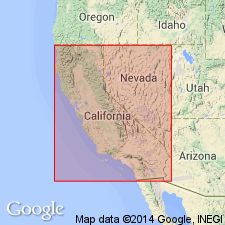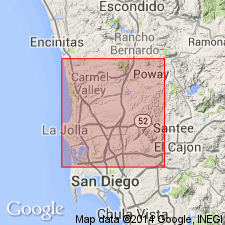
- Usage in publication:
-
- Friars Formation*
- Modifications:
-
- Named
- Dominant lithology:
-
- Sandstone
- AAPG geologic province:
-
- Peninsular Ranges province
Summary:
Named for exposures along and north of Friars Road. Type section designated as exposures on north wall of Mission Valley, 32 deg 46.0'N, 117 deg 10.8'W, San Diego Co, CA. Is uppermost member (of 6) of La Jolla Group. Rocks formerly included in part of Hanna's (1926) Rose Canyon Shale Member of former La Jolla Formation. Consists of yellowish-gray, medium-grained, nonmarine friable sandstone containing several dark-greenish-gray sandy claystone beds. Is 35 m thick at type. Conformably overlies Scripps Formation (new) of La Jolla Group. Underlies Stadium Conglomerate of Poway Group. Age is considered to be middle and late Eocene based on fossil tooth found 6 m below base of Stadium Conglomerate and fossil evidence from adjacent formations.
Source: GNU records (USGS DDS-6; Menlo GNULEX).

- Usage in publication:
-
- Friars Formation
- Modifications:
-
- Biostratigraphic dating
- AAPG geologic province:
-
- Peninsular Ranges province
Summary:
Few "Transition Stage" fossils are listed with location from Friar Formation. "A 'Transition' and probably also in part 'Domengine' age for most of the Friars Formation is indicated by its intertonguing relationship with the Scripps Formation. ... The uppermost part of the unit, based upon stratigraphic position, may be either of 'Transition' or 'Tejon' age (middle Eocene)."
Source: GNU records (USGS DDS-6; Menlo GNULEX).

- Usage in publication:
-
- Friars Formation*
- Modifications:
-
- Age modified
- AAPG geologic province:
-
- Peninsular Ranges province
Summary:
Age revised from middle and late Eocene to: middle Eocene based on stratigraphic relations [and fossil pollen and spores(?)].
Source: GNU records (USGS DDS-6; Menlo GNULEX).
For more information, please contact Nancy Stamm, Geologic Names Committee Secretary.
Asterisk (*) indicates published by U.S. Geological Survey authors.
"No current usage" (†) implies that a name has been abandoned or has fallen into disuse. Former usage and, if known, replacement name given in parentheses ( ).
Slash (/) indicates name conflicts with nomenclatural guidelines (CSN, 1933; ACSN, 1961, 1970; NACSN, 1983, 2005, 2021). May be explained within brackets ([ ]).

